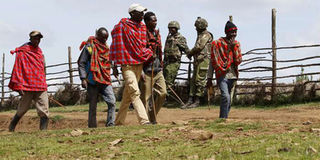17 counties conflict hot spots

Armed youth from the Maasai community go to attend a peace meeting at Kwa Kiramba in Olkurto, Narok County, on January 7, 2016. IEBC has indicated that Meru, Narok, Nakuru, Baringo, Nandi, Kisumu, Siaya, Homa Bay and Migori are areas prone to conflicts. PHOTO | SULEIMAN MBATIAH | NATION MEDIA GROUP
What you need to know:
- The Electoral Risk Mapping shows Tana River, Lamu, Kwale, Garissa, Wajir, Mandera, Marsabit and Isiolo as counties with high number of conflicts.
- The commission’s communication and public affairs manager, Mr Andrew Limo, said they had met different stakeholders to discuss ways to curb threats to the election process in all counties.
The electoral team has identified 17 counties as having high incidence of conflict.
The Independent Electoral and Boundaries Commission (IEBC) made the conclusion when they mapped violence hot spots in the country.
The Electoral Risk Mapping shows Tana River, Lamu, Kwale, Garissa, Wajir, Mandera, Marsabit and Isiolo as counties with high number of conflicts.
Others are Meru, Narok, Nakuru, Baringo, Nandi, Kisumu, Siaya, Homa Bay and Migori.
The conflicts include cattle rustling, terror attacks, protests and riots, ethnic clashes, robberies and agro-pastoralist.
The June analysis on threats of insecurity to the electoral process in Kenya shows Turkana, Samburu, Laikipia, Nyeri, Kiambu and Kilifi counties as having an average number of incidents of conflicts.
Counties with low number of incidents include Kitui, Kajiado, Makueni, Taita-Taveta and Embu.
The commission’s communication and public affairs manager, Mr Andrew Limo, said they had met different stakeholders to discuss ways to curb threats to the election process in all counties.
He said the Electoral Risk Management Tool developed with the help of International Institute of Democracy and Election Assistance would be used to identify risk factors relevant in an electoral context and offer prevention and mitigation measures.
“This is a tool that was developed after realisation that despite the existence of early warning tools...none had a specific focus on elections,” he said.
“Due to the Kenyan experience in 2007/2008 this was an opportunity to pilot the tool and Kenya became the first country where the tool was piloted during pre-election and election period.”





